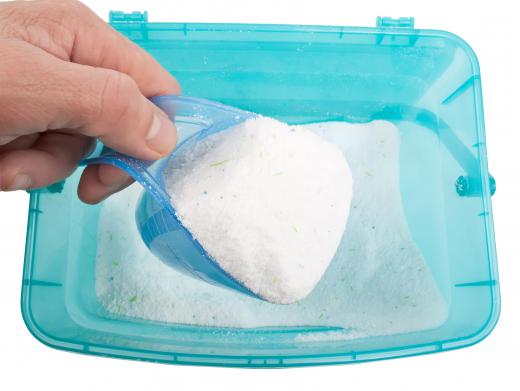What Is a Buffering Agent?
In acid-base chemistry, a buffering agent is a substance that can be used to maintain a solution at a constant pH, or level of acidity-alkalinity. Acids in aqueous solution provide hydronium (H3O+) ions, while alkalis provide hydroxide (OH-) ions. The pH of the solution is a measure of the relative concentrations of these ions. A solution containing a buffering agent can, up to a point, absorb the additional hydronium or hydroxide ions that are introduced when an acid or base is added without any alteration to the H3O+/OH- ratio, and thus no change in pH. Naturally occurring buffers are found in biological systems and buffering agents have many uses in chemistry and industry.
When an acid is dissolved in water, it will — to a greater or lesser extent — ionize into H+ ions and negatively charged anions. The H+ ions combine with water to form hydronium ions (H3O+) and the negative anion is known as the conjugate base. Aqueous hydrochloric acid, for example, forms hydronium ions and the conjugate base is the chloride ion: HCl + H2O →

A mixture containing a salt of a weak acid along with the acid from which it is derived can often be used as an acidic buffering agent; the salt ensures a plentiful supply of the acid's conjugate base. Strong acids and their salts are not useful as buffering agents, as an acidic buffering agent needs large amounts of the acid to be present in non-ionized form and because the pH, in any case, usually needs to be maintained at a near neutral or only moderately acidic or alkaline value. Similarly, an alkaline buffering agent usually involves a salt of a weak alkali along with the alkali itself.

A simple example of an acidic buffering solution is an aqueous solution of acetic acid and sodium acetate. Acetic acid is a weak acid, so most of it will not be ionized. On adding an acid, the additional hydronium ions will react with the acetate ions from the sodium acetate, forming more acetic acid, which will remain mostly non-ionized and so will not have much effect on the pH. When an alkali is added, the additional hydroxide (OH-) ions will react with the acetic acid to form acetate ions and water, and with the smaller amount of hydronium ions to form more water, again with little effect on the pH.

Living organisms employ buffering agents in a number of roles. For example, the pH of blood needs to be kept close to 7.4 — slightly on the alkaline side of neutral. Given that a wide variety of chemicals of varying acidity and alkalinity can enter the bloodstream from food that is ingested, a buffering agent is necessary to ensure that this value is maintained. This is achieved by a combination of carbonic acid (H2CO3) and hydrogen carbonate (HCO3-) ions.

Buffering agents are widely used in industry and in many common products. They are used in detergents, in foods, and in brewing to ensure that the pH stays within the range required by the yeasts responsible for fermentation. Shampoo works best when it is slightly acid and will generally contain a buffering agent to prevent loss of acidity during use. Buffers are also much used in biology and biochemistry. Good's buffers, developed in the 1960s by N.E. Good, are a group of buffering agents carefully designed not to interfere with biological reactions.
AS FEATURED ON:
AS FEATURED ON:














Discuss this Article
Post your comments